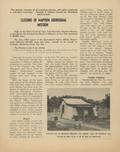The campaign for Mapoon
The Cairns Aboriginal and Torres Strait Islander Advancement League began publicising the events at Mapoon and alerted the Federal Council for Aboriginal Advancement (FCAA). The Federal Council further publicised what was happening and began to campaign for the people's right to remain at the mission.
The struggle for Mapoon
Cairns Aboriginal and Torres Strait Islander Advancement League, 6 November 1962, Joe McGinness Papers, MS 3718, Australian Institute of Aboriginal and Torres Strait islander Studies, Canberra
On 15 November 1963, however, police were brought in to force people to leave their homes. One eyewitness account said:
They ... came in the night and ordered the people to pack their belongings and drilled them in the night down to the mission and they slept in the cottage. Two coloured police sat all night and two white policemen slept in the middle of the people. They said the people might run away and they will lose their job. They didn't give the people time to have a bath or eat their supper ... The store (at Mapoon) was short of food. Mr ... a worker of the Department of Native Affairs allowed very little to the people for two weeks and on the third week everybody was allowed 4 lbs of flour, rice, sugar. You can see how little it is to feed a big family for a week. [1]
Mrs Jean Jimmy, spokeswoman for the Mapoon community, made the long journey south from Cape York to Canberra to attend the Federal Council for the Advancement of Aborigines and Torres Strait Islanders (FCAATSI) annual conference in 1964. She spoke of the people seeing the church they had helped build being torched, of their homes being burned down, and of no compensation being offered.
Pauline Pickford recalls meeting Mrs Jimmy in Canberra:
I remember Mrs Jimmy. Mrs Jean Jimmy. Mrs Jimmy was a most wonderful woman. To get the money to come to her first conference she went crocodile shooting, and I can't remember how many crocodiles she had to shoot to get there, but she got there.
[Interviewer] When would her first meeting have been now? Was it early 60s?
It was one that was at Bruce Hall, so it was 1963 or 1964. She was a lovely woman and she's the one that you heard that wonderful expression, 'they make our rights wrongs'. It's never left me. That's a beautiful expression. And those people from up there spoke a language that you could almost say was biblical. Truly. They used their wordings of the Bible to put their case. Beautiful. It sort of knocks you sideways when you hear it. And she - I met her a second time - they had to leave of course, and she was up in the range somewhere with her family. I think she was probably getting a little bit sick of all the people that were coming because she was a very quiet person, and people became very interested in the story of the bauxite and how they were forced off by gunpoint, and all that sort of thing. [2]
The Federal Council for Aboriginal Advancement reminded activists that its fifth and final guiding principle was 'the absolute retention of all remaining reserves with native communal or individual ownership'. It pointed out that the action of the Queensland Native Affairs Department broke Article 9 of the Universal Declaration of Human Rights that '[n]o-one shall be subjected to arbitrary arrest, detention or exile'. The issue was taken up by the London Anti-Slavery Society, whose secretary pointed out to the Queensland Minister for Native Affairs that the world was watching these events. (See page 4 of 'Closure of Mapoon Aboriginal Mission'.)
Despite efforts on the part of local, national and international bodies, the forced move to Bamaga (which became known as New Mapoon) on the tip of Cape York was effected. Mrs Jimmy, nevertheless, vowed that she and other Mapoon residents would not rest until they could return to the land of their birth.
Postscript
From the late 1970s, people began returning to Mapoon. In 2000, Mapoon was formally recognised as a Deed of Grant in Trust Community (DOGIT) with status similar to a shire council. Under this system, a locally elected council governs the community. In 2003 Mapoon received a 'Strengthening Indigenous Communities' award from the National Office for Local Government.
Related resources
People
Organisations
Anti-Slavery Society
Cairns Aboriginal and Torres Strait Islander Advancement League
Federal Council for Aboriginal Advancement

